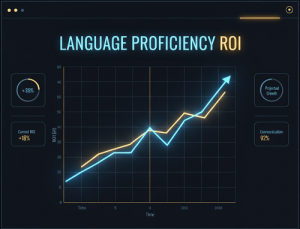Investing in employee development is a crucial driver of business growth and success. For global companies, language training is a significant part of this investment. But how can you be sure that your investment in language courses is truly paying off? How do you measure the actual progress and, most importantly, the return on investment (ROI) of such initiatives when the benefits seem intangible?
Many organizations operate on an assumption of proficiency, but the reality is that language skill is not a static attribute. Without a clear system to measure it, companies are flying blind, unable to distinguish between genuine fluency and a “good enough” level of communication that could be masking critical misunderstandings, lost opportunities, and operational friction.
Case study: a global leader in energy management
Let’s consider the case of a leading international company in the energy management and data solutions sector. With a presence in over 20 countries and a diverse workforce, this company recognized the importance of strong language skills for its employees to collaborate effectively across borders and serve its global clientele. They were investing significantly in language courses but struggled to answer a critical question: “Are our employees’ language skills genuinely improving? Are miscommunications on international project calls causing subtle but costly delays? Is our investment in training yielding tangible results or just ticking a box?”
The company was experiencing friction points: promising junior managers hesitated to speak up in global meetings, and the sales team felt they weren’t building the same level of rapport with international clients. They knew they had a problem, but they couldn’t quantify it.
This is why they partnered with us to implement a system of regular language audits. Instead of a single test, we established an assessment cycle for employees in key international-facing roles. The audit isn’t just a multiple-choice grammar test – it is a holistic evaluation of the key skills, all contextualized for their business environment.
By implementing our regular language audits, the company was able to achieve a multi-layered transformation:
- Track progress over time: instead of relying on one-off tests, they can now monitor the development of their employees’ language skills on an ongoing basis. This provides them with valuable data to assess the effectiveness of their language courses and make informed decisions about future training initiatives.
- Identify and address specific needs: our audits goes beyond a simple pass/fail assessment. They provide a detailed analysis of each employee’s strengths and weaknesses, highlighting specific areas for improvement. For example, some employees excelled in speaking but struggled with written communication, while others had a strong grasp of grammar but lacked confidence in speaking. This level of detail allows the company to tailor its training programs to address the specific needs of its employees, making them more effective and engaging.
- Optimize training budgets: by identifying the most critical training needs, the company is able to allocate its resources more effectively. Instead of offering generic language courses to all employees, they can now focus on targeted training that addressed the specific challenges faced by different teams and individuals. This not only improves the ROI of their training but also enhanced employee motivation and engagement.
The challenge of measuring language proficiency
Many companies invest heavily in language courses for their employees, hoping to improve communication, foster international collaboration, and enhance customer relations. However, they often lack a reliable system to measure the effectiveness of these courses.
- Pre-hire testing: a language test during the recruitment process offers a valuable baseline but is ultimately just a snapshot in time. It doesn’t account for skill loss from lack of use, nor does it track the growth of an employee who actively engages in a new language on the job. A candidate who tested at a B2 level on the Common European Framework of Reference for Languages (CEFR) might progress to a C1 through daily practice, or regress to a B1 if their role doesn’t require it.
- Self-assessments: relying on employees to rate their own skills is notoriously unreliable. It’s susceptible to both the Dunning-Kruger effect (where individuals with low ability overestimate their competence) and Impostor Syndrome (where high-achievers doubt their skills). This leads to inaccurate data that cannot be trusted for strategic planning.
- Course completion certificates: a certificate proves attendance, not proficiency. Completing an “Advanced Business English” course doesn’t guarantee an employee can confidently lead a negotiation with a native speaker or draft a nuanced legal document under pressure. It measures effort, not outcome.
These methods fail to track progress, identify specific areas for improvement, and ensure that training is aligned with the company’s evolving strategic needs. Continuous language audits offer a range of benefits that go far beyond simple assessment:
- Data-driven decision making: regular audits provide HR professionals and talent managers with the data they need to make strategic decisions about employee development. They can identify skills gaps, track the effectiveness of training programs, and demonstrate the value of their initiatives to senior leadership.
- Personalized and motivating learning journeys: by identifying individual strengths and weaknesses, audits enable the creation of personalized learning journeys that are tailored to the specific needs of each employee. This not only enhances the effectiveness of the training but also boosts employee motivation and engagement.
- Proactive talent management and mobility: regular audits can help identify high-potential employees with strong language skills who can be groomed for future leadership roles in the global organization. They can also highlight areas where additional support is needed to ensure that all employees have the language skills they need to succeed in their roles.
Moving beyond pre-hire testing to regularly assess, monitor, and develop employee language skills
Effective communication is no longer a “nice-to-have” – it’s the bedrock of innovation, the enabler of efficiency, and the foundation of global teamwork. Companies that invest in the language skills of their employees are better equipped to compete in the global marketplace, foster innovation, and build strong relationships with customers and partners around the world.
However, simply investing in language courses is not enough. To maximize the ROI of your training and ensure that your employees have the language skills they need to succeed, you need a system for continuous assessment and monitoring. Regular language audits provide a powerful solution, enabling you to track progress, identify specific needs, diagnose specific needs, and make intelligent decisions about employee development.
Stop guessing and start measuring. Build a more confident, connected, and effective global workforce. Contact us today to learn more about our language audit solutions and how we can help you turn your language training into a measurable competitive advantage.






